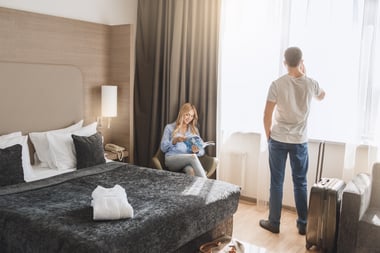Here at Net Affinity, each individual member of our team is bursting with knowledge, passion and skill that needs to be shared. That’s where our Employee Series comes into play. We will be giving you an insight into the expertise of our team members through interviews on various topics with them!
This week we’re chatting with Dan Prado, our design manager. Dan will be talking us through his history with design, his top tips for designing a website and the designers that you should be taking notes from.
1. Where and when did you begin designing?
In 2006 I graduated in Digital Design with focus on Web Design at Anhembi Morumbi University in Sao Paulo, Brazil. However, everything started when I was 10-12 years old and had my first contact with a personal computer. My dad brought a 386 PC home and I was fascinated! I unusually began making some illustrations on Autocad for MS-DOS- a software designer for engineering and floor-plans.
The real game changer was our first dial-up internet connection when I started to visit websites. I researched how to have my own web page online until I was able to create a personal website where you could download and play Atari games on your PC. The more I learned the more I wanted to create. This was around the year 2000. It was then that I knew that this was what I wanted to do, and have never stopped since.
2. Where do you get inspiration?
I believe that everything can be a source of inspiration. TV shows, movie posters and advertisements can reveal design trends. City, subway and train signs can teach you a lot about simplicity, readability and functionality. Big famous apps like Spotify, Netflix and Airbnb are a great reference of good UX. I also keep following the latest from the big three tech giants. For example, what’s new with Apple’s Human Interface Design, updates from Google’s Material design or Microsoft’s Fluent Design. Users consume these products massively on a daily basis. So, if you want to have an UI with good UX and have a smooth conversation between your product and your guest, knowing what’s being done in the industry will make your job a lot easier. A good tip for designing inspiration is to follow Muzli and pop into Uplabs from time to time, to see what other designers are doing.

3. Does UX play a big role in your approach?
User experience is the top priority on all my projects. Your website or app will fail if it doesn’t provide a smooth and friction-less experience between your product and the user. Imagine the most beautiful and shiny car, but without a wheel. It becomes useless. An app or website with a bad UX is the same, it loses its main function and will frustrate your user. With a good UX your guest should not think of what to do. His/her actions will just happen naturally and intuitively. The final experience will be pleasant, making him/her return and recommend to more users. During the whole process your guest should not be drawn to pay attention to your website UX. If your user stops and wonders: “this button shouldn’t be here” or “this label is very confusing”, then there’s something wrong with your app/website.
4. Are there any websites/apps you particularly like?
One of the main designs I love and reference because of its good UX practices, is Airbnb. In my opinion, they’re the best example on how to be objective, straight to the point but beautiful and clean at the same time. From the time you perform a search until you complete a full booking, you have the same smooth experience no matter what device you’re in. If you’re in a big desktop screen or on your mobile phone, you’ll get the best, cleanest user experience.

5. What’s going to change in design in the next 5 years?
I believe that in 5 years time we’ll have less types of touch/click inputs and more visual/audio inputs. With the recent advances in AI, virtual reality and augmented reality (with wearables and smart glasses) we’ll be less required to touch, swipe or type to achieve something. Instead, I believe we’ll speak or point our phones, cameras or smart glasses towards something and get results. This will have some influence on how we design more conventional interfaces and UX’s. Therefore, users will naturally expect a different type of interaction with our products.
6. People are now on board with responsive design but the number of different types and sizes of devices continues to grow. How do you deal with this?
Due to the continuous increase of different types and sizes of devices, responsive design has become more challenging, but also more exciting (and I’ll tell you why). The challenge of conveying the same experience and allowing the user to execute the same task, but on different devices is what makes it exciting!
To design for multiple devices you need to look into your product not from an aesthetic point of view, but rather from a functional perspective instead. Step back and ask what is the main goal that the user needs to achieve with your product? Then, you should trace the path of actions they need to take and finally, you jump into the visuals. You need to break the main elements in your process into small pieces, such as grids, lists, forms and buttons. They need to be treated as single elements and components. We call this methodology atomic design.
We design from the smaller part, assembling them together until they become something bigger and with form. This could be for a small interface (mobile phone) or a larger interface (laptop). The more space you have, the more elements you can include to help your user to achieve their main goal. This also makes your design more consistent. Obviously, the more devices we face, the more interfaces, prototypes and tests we need to make. This will ensure that the user has the same experience, no matter what device they’re interacting with your product on.

7. What websites or apps do you look at every day?
My routine can be split between mobile and desktop. On my commute to work, I listen to music and podcasts through PocketCasts and Spotify. I also browse the news on Google News, Flipboard and Reddit. On desktop I visit plenty of news websites and Flipboard and Spotify are also on there. I’m very fond of the Google ecosystem, so calendar, Gmail and Google Drive are frequently accessed throughout my day.
For website inspiration and to keep up to date with the trends, as I mentioned before, I go to Muzli and Uplaps. From those I find amazing work from designers posted on Dribble, Behance, Awwwards, SiteInspire and lots more. Oh, don’t forget Product Hunt to see the hottest and trending products being released every day.
8. What type of trends are happening in hotel web design?
Hotels are realizing more and more that to sell your property, one image tells more than a hundred words. Today it is very affordable to hire a professional photographer or videographer that will provide you with stunning stills, aerial drone shots or a promo video that really sells the experience of staying at your hotel. Nowadays hotels are incorporating these beautiful images and video footage to their design to make their website stand out against their competitors.
9. What’s interesting and what’s limiting about designing for hotels?
The interesting part of designing for hotels is the challenge to get the atmosphere of the property and translate it into the digital environment. The aim is to make the potential guest feel as though they are actually at the hotel. I see hotels as if they are people with their own personalities and I try to translate this into the design I’m creating. Some can be more funky, casual and colorful. Some are more serious, charming and classic. Each one has its own way to be, that makes them very unique.
The limiting part is that in the same way that we need to be creative, we need to keep the focus on conversion. At the end of the day, the hotel has its online presence to increase and get more bookings. That’s when our expertise needs to speak out loud and make sure the website has its own face, but works perfectly for its purpose, which is to increase direct bookings for hotels.
10. What’s your favorite hotel?
I once stayed at the Knightsbrook Hotel. They have a stunning reception hall and a beautiful golf course for golf lovers (which is not my case as I’m terrible at it). They also have a great restaurant (the breakfast was amazing) and a lovely spa to recharge your batteries on a city getaway!
11. Tell me 3 things I should know about you.
- I’m from the cosmopolitan city Sao Paulo, Brazil, but living 8 years in Ireland, which I already call home.
- I love music. I play a bit of guitar and I used to play the drums when I was a teenager. I’m into photography as well, if you’d like to follow me on Instagram to see my photo work, you can click here.
- I sing at karaokes, making impressions of Louis Armstrong’s “What a wonderful world”.



